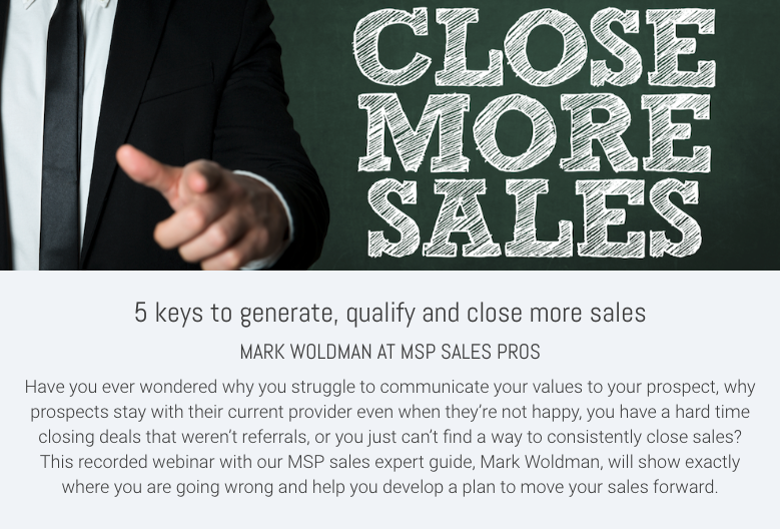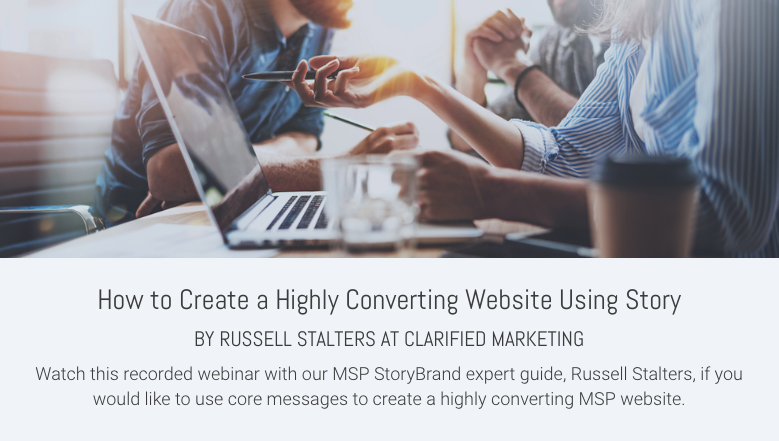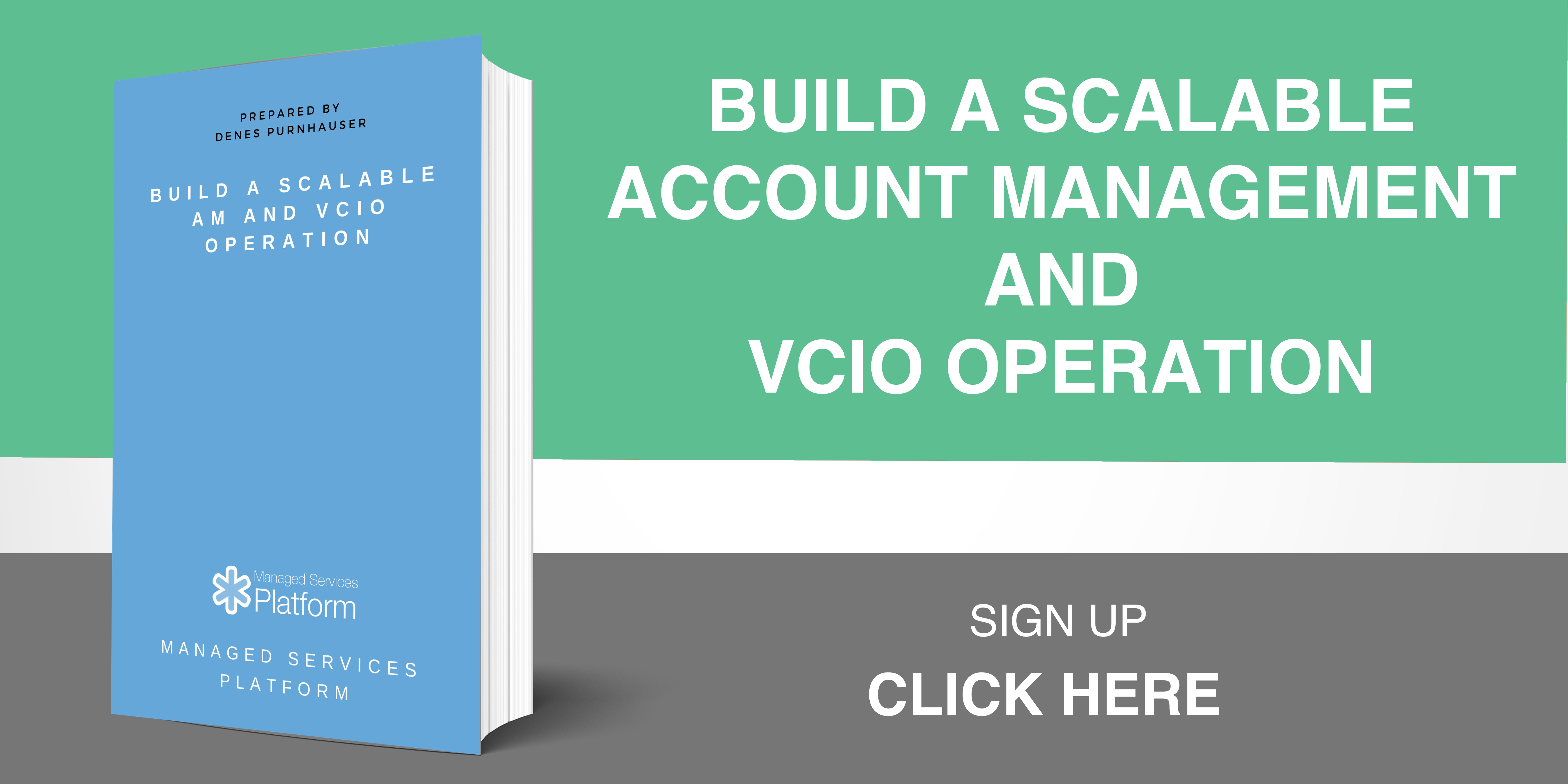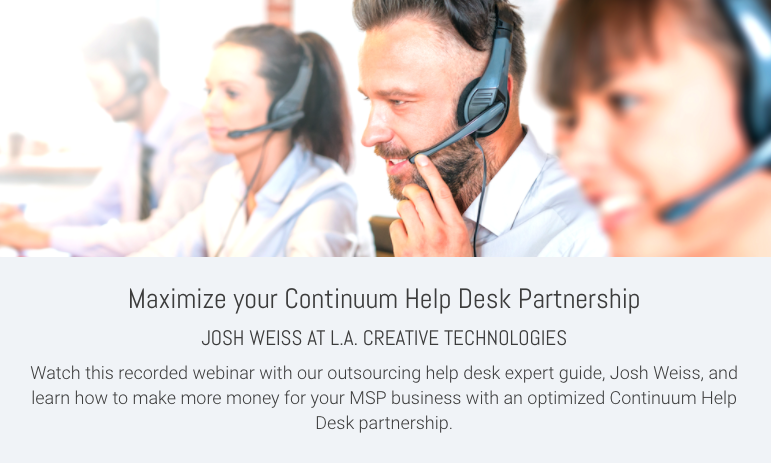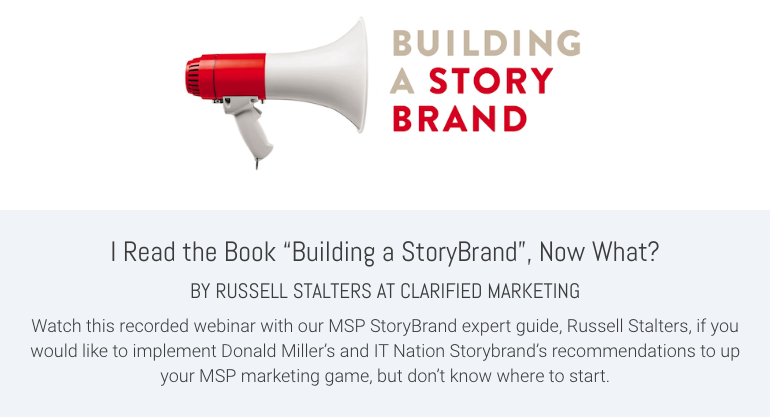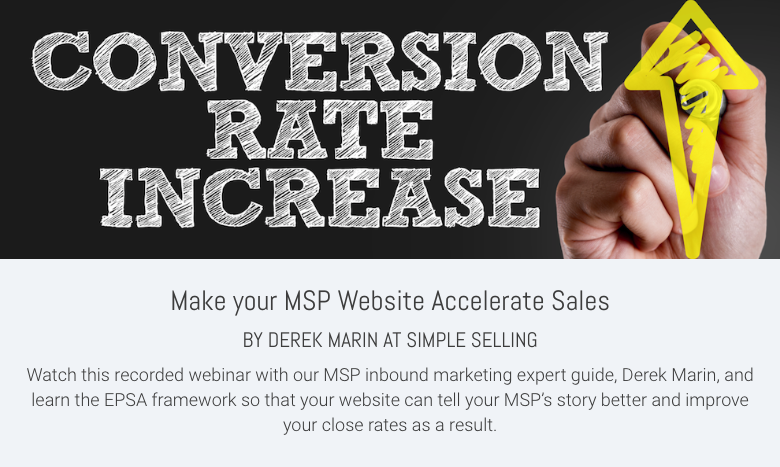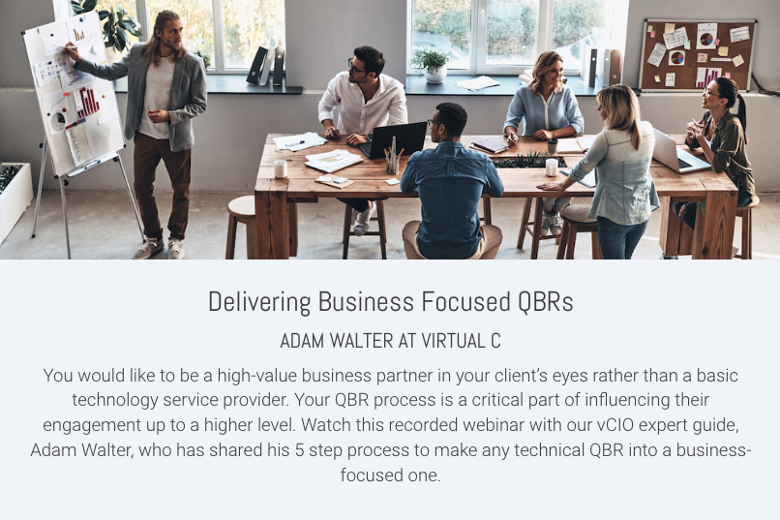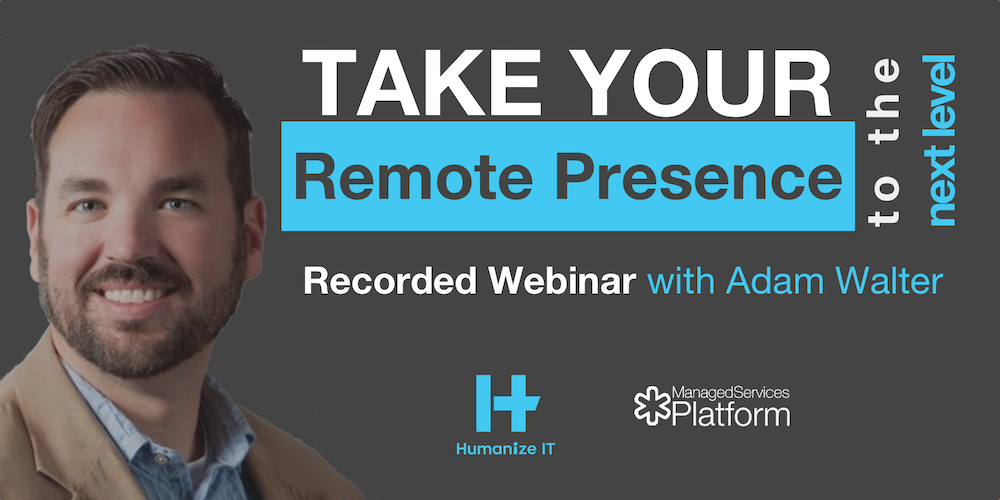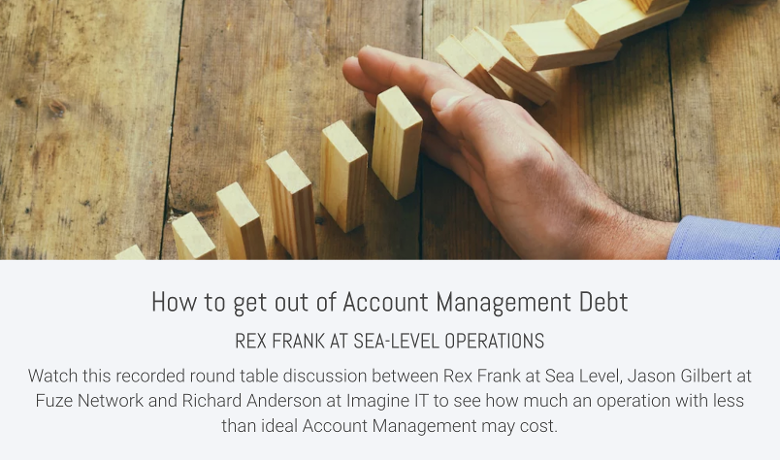5 Reasons You Lose Deals to Your Competitors
By Mark Woldman on October 18 2019
Are you struggling to sell Managed Services?
If you are struggling to sell services, don't worry, you are not alone. MSPs of all sizes are feeling the pinch when it comes to sales, so this struggle is not exclusive to you.
Factors such as increases in competition, frugal clients, poor product positioning, diminishing referrals and lack of overall strategy, cumulatively contribute to a continual decline in sales.
Leads are at an all time low and the cost of generating leads is at an all time high. In light of this, it is more important than ever to utilize ways to set yourself apart from the crowd, secure your role as an industry expert and thus, gain credibility from existing and future clients.
With referrals being fewer, and certainly further in between, it is increasingly harder to grow your business with any sort of consistency. And, SMBs are bombarded with sales and marketing messages from IT companies every day, making it increasingly difficult for you to land meetings with qualified companies.
This makes it imperative that you find a way to stand out from the competition and find a way to convert leads into clients. If you look like the current IT provider or, just like every other MSP out there, with similar service offerings, you are virtually giving the prospect a reason to buy on price.
If you want to put an end to the dreaded ‘Lead-Proposal-Closed Lost’ cycle you will need to become more effective at creating the vision of a higher value experience and demonstrate you have the ability to deliver that experience.
Does this sound like you?
"We'll be just fine once we find a way to get in front of more prospects." While this sounds logical, nothing could be further from the truth. Even referrals do not have the high close ratios which we came to expect for so long. And, leads generated by your own efforts are much more skeptical, with the industry average close ratio well below 30%. Because of this you must have a strategy and a process that sets you up for success.
DIFFERENTIATE YOURSELF FROM YOUR COMPETITION AND
BECOME SALES READY IN 30 DAYS
Unleash Your Growth Potential
By Denes Purnhauser on October 11 2019
Whether you’re a “one-man-band”, an emerging MSP with a handful of people, a team about to reach the 20 people mark or even a large 50+ organization you have one thing in common: you may have reached a growth plateau and want to unleash your potential to get to the next level. In hindsight you can recognize that it all comes back to bottlenecks in your organization’s capabilities to unleash those potentials role by role: Account Management, vCIO, Technical Account Management, IT Sales, Cyber Security and even the owners. All of them have low-hanging-fruit opportunities and by snagging those you can get to the next level in a smooth, predictable way.
Understand your Untapped Growth Potential
Let's first check your company roles and how they can be bottlenecks in your growth.

- Account managers are not providing a predictable stream of projects and cannot support a steady cash-flow
- vCIOs are not upgrading clients to strategic-business vCIO services and cannot get paid by clients
- Technical Account Managers are not adopting new technology standards and cannot set the base for efficient service delivery
- Owners are not setting proper structure for AM/vCIO and cannot keep the team accountable
- Sales People are not getting in front of ideal prospects and cannot differentiate themselves from the competition
- vCSOs are not upgrading clients to modern cyber security services and cannot get paid by clients
You might be a small company and you as the owner might be wearing all of these hats. If you had to choose only one, which would be the most important?
Unleash your Growth Potential one role at a time
Working on every role at the same time will not let you focus or ever achieve a breakthrough. Pick the "rock" you want to work on during the specific quarter and focus on that role. Here are some examples how:

Watch the complete seminar to learn how to unleash your potential with different roles in your organization. Expert guides will walk you through making it happen.
- How to grow with Account Management: Sell High-Value, standard projects with a proactive process by Myles Olson
- How to grow with vCIO: Drive Strategic Conversations and take on the execution by Adam Walter
- How to grow with Technical Account Management: Develop Technology Standards and Adopt them with all of your clients by Skip Ziegler
- How to grow with Sales: Generate qualified leads and differentiate with client experience by Mark Woldman
- How to grow with Cyber Security: Make cyber security make sense to clients and offer packages they can buy by Caleb Christopher
- How to grow with Focus on Execution: Create structures for AM/vCIO, keep the team in focus and ensure accountability by Elissa Kulczycki
How to Unleash your Growth Potential
The traditional way of developing a company is to develop best practices, implement those to the normal daily life and keep vigilant with them during the day-to-day operation. As you have no resources this leads to bursts of projects without sustainable outcomes. Think about why the six roles of your company still have bottlenecks.
Your potential of growth depends on three things:
- Your Talent - the strengths of your team
- Experts help you - people can take the workload from your shoulders
- Tools help you - applications can offer you a productive framework and streamlined execution
By building your MSP with Expert Guides and Purpose-Built Software you will drastically cut the time to success. This will help you to leverage your current resources to break through the barriers and stop spinning your wheels.
5 Steps for sustainable growth
Growing your business can be accomplished through a series of quick high intensity bursts, but will manifest in unsustainable growth with short peaks of results. We want to make sure you have a long-term vision, and can break down the big rocks to stones you can deliver. Those big rocks don’t fit through your system - fix the bottleneck and keep it sustainable. Then move your attention to the next goal but build on top of the previous efforts.

- Platform Orientation Meeting - if you have no membership yet, let's start exploring your goals and discover how the platform might serve your growth
- Growth Readiness Assessment - assess your readiness of growth and identify the bottlenecks holding you back and preventing your breakthrough
- Smart Growth Action Plan - build a SMART goal and plan your next steps to achieve those goals with an action plan
- Execute your Rock - do it by yourself, pick an expert guide's education or engage with a 1-many or 1-1 program to push things through
- Repeat - Go back to the drawing board, choose your next goal and execute the rock of the next quarter....
Conclusion
Regardless of your company size you always have growth potential. By identifying the low-hanging-fruit with one role, you are able to generate the momentum and the positive cash needed to fuel further growth. Being more conscious, focusing on one role at a time and making sure the role will stay sustainable will deliver a compounding positive effect over time.
How Do I Get Visitors to Engage with My Website?
By Russell Stalters on October 8 2019
How to Do I Get Visitors to Engage with My Website?
I mentioned this in my last Blog post. We live in a very “noisy” world and we need to grab their attention in less than a couple of seconds.
This is true for our website too. People don’t read website content any longer. When someone lands on your homepage they will start skimming the page very quickly to decide if they want to spend more time diving deeper.
“But, they went to my page because we met at a networking event!”
It doesn’t matter.
You have 5-8 seconds to capture their attention. Studies have shown that on a computer web browser people scan the webpage in a Z pattern. Left to right across the top, then down to the lower left and across the bottom of the page before they start scrolling down. We call this area before they scroll down “above the fold” which is an old newspaper term.

So, how do we grab their attention?
When they land on the homepage we have to instantly answer three questions…
- What is the big problem you solve?
- What will my life look like after I buy your product or service?
- How do I buy? or What is the first step in the sales process.
Once we have them hooked and our visitor decides to scroll down we need to tell a story.
Not our story or the story of our company. We need to invite them into their story. A story of transformation.
One of the best ways to create your customer’s story of transformation is to use the StoryBrand methodology as described in Donald Miller’s book “Building a StoryBrand: Clarify Your Message So Customers Will Listen”. As a StoryBrand Guide I help MSPs implement the StoryBrand methodology to attract their ideal clients, get more meetings, and grow their business.
During this session I will provide a blueprint for creating a highly converting website homepage. He will share best practices on how to implement the recommendations from the great book, “Building a StoryBrand”.
I will also provide live feedback and improvement recommendations for attendee’s websites during the webinar.
So, make sure you register here and be ready to get feedback on your website.
How you steal money from your own MSP and how to stop doing it
By Denes Purnhauser on October 4 2019
Unfortunately this is not a cheap cliffhanger title just to grab your attention. You’re reading it on your mobile so I’ll be brief like a bumper sticker: you steal money from your own MSP because you address the symptoms of problems with tactical Bursts of effort. That only generates more work and expends resources to generate tiny bits of unsustainable value. Sure, you feel busy and productive, but you don’t solve the problems in the long run. Sound familiar? Let's take an example and see how to fix it with Smart Goals and an action plan.
We’ll go through this process by analyzing a typical MSP use case: Account Management.
1. Focusing on the symptom instead of the root problems
Say you go to a client meeting that doesn’t go as planned. Maybe the client was not engaged, they did not seem to value your services, they weren’t interested in the next project you offer or were simply looking for a price cut of your services.
You come out feeling "we are no longer relevant", "our competition is stronger", or “we need a better QBR process". These are not the root problems to solve - these are the symptoms.
2. Focusing on a tactical solution
Now you feel you should take action and start browsing the net on how to conduct a better client meeting and become more relevant.
You check out some software applications and spend some time evaluating them, download templates, figure out the best processes and talk to peers about how they do their client meetings.
You land a software package, the team is happy and feel the solution is on the way.
3. Premature scaling:
As you execute the implementation you start to see the big picture and imagine how you’ll be doing 15 QBRs monthly for your 45 clients. The challenge becomes terrifying - the amount of activities and tasks to get done, all the preparation and connecting the dots. You start working on processes, customizing collaterals, and working on the process day and night.
Then time goes by and a handful of meetings is done; the team feels this is way too much effort for too little gain and loses momentum. The team finds another urgent project to work on and suddenly the QBRs fall by the wayside, and client meetings are not delivered.
Does this not describe what’s happening with your MSP? Let's go through this list...
- Why did your vCIO initiatives, IT Strategy Services and monetization of IT consultancy never take off?
- Why can your Technical Account Managers not communicate the increased values to clients and you find clients don’t value your services anymore?
- Why is your team still addressing the noisy clients rather than focusing on the high value clients with opportunities?
- Why can’t you get in front of new prospects and close high-value opportunities in a predictable way?
- Why do you cover the increased costs of IT security services in your MSP package rather than monetizing on IT Security as add-on services?
This is not your fault... this is a common symptom of what’s missing - a strategic approach to make improvements in your company.. Let's try another spin on this story:
1. Analyzing the symptoms but working on the root problems:
You go to that client meeting which did not go as planned. The client wasn’t engaged, didn’t seem to value your services, and were only interested in a price cut and not your next projects.
You go back and think it through and you realize that your service company has no Client Engagement "Department" at all. No foundations, no client segments, no roles, no playbooks defined and clients are generally served in a technical/tactical level but are not managed in a strategic way. Holy smokes, we need to do something.
We need to define the complete Account Management program and create resources to get somebody to run it!
2. Set a Smart Goal for a focused Burst:
We need a Burst of effective effort which will start the process in a low maturity setting and help us generate revenues to make it sustainable, work on the system and fine tune it. The goal, however, is not to get it perfect right away, only to start it and get momentum so you can set the foundation to fix it in the long term.
Set a Smart Goal for the quarter: "Increase Project Revenues by $100k in the next 90 days". We do not say "do a better QBR" or "Structure Account Management". We say something quite specific that we can achieve if we reverse engineer the goal to manageable pieces. Like doing 10 QBRs and landing $10,000 each. Now we can focus on the best course of action to land $10k on each QBR. This is actionable, feasible, and the team can actually get results AND develop the process at the same time.
3. Execute the Burst with the end in mind:
Now we have a plan, so we can work on the details that will generate momentum. We’re going to use the Burst of effort to generate as much value as we can with the limited resources we have. But we’ll focus on revenue generation which will be used to create the resources for the higher maturity operation later.
- We deliver QBRs to 10 clients who have security and infrastructure technology debts.
- We generate project roadmaps focusing on security and infrastructure averaging $10,000.
- We list 5 -10 low-hanging-fruit projects and customize our collaterals to focus on selling only those items to make the process simple enough.
- We run a high-value client meeting that results in agreement on the relevant projects.
- We do not customize, do not try to build a rocket ship and we do not automate... just ship it.
4. Create a machine to grow the momentum:
Now the Burst of effort was intentionally "immature", "simple", "minimum viable" or "beta". Why? Because the goal was not to fix symptoms but to be able to create capacity for delivering the required client engagement activities, introduce the concepts to clients and test the waters before we scale anything. We do not have an integrated approach, things are clumsy internally but the client facing part is optimized.
- We use the projects to get some breathing space and positive cash-flow,
- We refine the process and start customization and automation,
- We build on top of the foundation of QBRs and start conducting them regularly with lower value clients, and
- We introduce new ideas and new outcomes for each new QBR and start adding new tools like plans, budgets, roadmaps and so on.
Conclusion:
Creating Smart Goals for a conscious Burst of effort with the end in mind and generating the capacity to put the process to the next level is a way to actually create something sustainable.
Without Smart Goals and the quick Burst, followed by no execution machine our initiatives, all we’ll become is noise makers, never taking off and not generating value within our MSP...like stealing money from ourselves?
7 Smart Tips to Maximize Your Continuum Help Desk Partnership
By Josh Weiss on September 18 2019
After my business grew from a break/fix it tech provider to a full fledged MSP, it was clear that I needed to offer 24/7 Help Desk service. I weighed the options and decided to outsource this role, choosing specifically to partner with Continuum’s Pittsburgh team. This partnership has thrived for the last 4+ years, expanding to encompass our Server Management, Security Operations, Network Management roles and more.
But, even though Continuum is an excellent partner, I learned the hard way that outsourcing a core operational process, like a Help Desk, can not be treated like ‘set it and forget it’. There are instances where it will not fulfil your needs... where you have to tailor it to fit your business. I also learned that the only way to take advantage of all that it offers is by first understanding how it works. It took me years and many mishaps to figure that out.
Outsourcing your Help Desk, easy? Sure... but not so fast!
Let’s get right to it. Here is the issue. Most often, your Help Desk is not integrated or responsive to you and your company’s needs. Certainly when I started, mine was not. I learned the hard way. You don’t have to. Here are 7 tips that will help you Maximize your Continuum Help Desk Partnership. And yes, the devil is in the details.
1. A Good Client Communication Strategy
Be sure to communicate to your clients the REAL benefits of working with a partner like Continuum and their outsourced Help Desk team. For example- they will have a Help Desk service even if Los Angeles gets hit by a missile. Their documentation and data will be safe with a company who can support their business, no matter what disaster might arise. Smaller companies simply can’t provide needed SLA’s without scalability. It’s not only important to share the REAL benefits but also to describe exactly what the Help Desk does, putting all that into a framework and a language that clients can understand.
2. Have Checklists for Complex Tasks
Complex tasks require that the partners have a process in place to keep mistakes at a minimum. The mistake many MSP’s make is not having an actionable process in place for all partnership activities, allowing all team players to understand the process... no matter where they are located or if they are new or old timers. Plus, what is sent to the team is both easy to understand and visualize, making what needs to be done very easy to assign work back and forth, no matter the complexity of the issue.3. Virtual Team Collaboration Process
This is more about collaboration. We already set the stage with proper communication strategy with the client. and managing complex procedures. The third one is about how to manage collaboration, as well as the process itself. First remember, the guys and gals at Continuum are real people.. not automated processes and they must be treated with respect. So instead of just creating a ticket with no communication why not actually talking to them. Ask real questions to help the process work smoothly kie- “Hey, can you tell me if this makes sense? Can you tell me if what I've assigned is correct? Can you make sure that you do this part and then you send another part to a different team?" Many call this team building, I call it collaboration and treating all members of the team as equals no matter where they are located.
4. Tactical Overview
This fourth tip is about having the proper tool set versus not having the proper tool set. Anyone who runs a MSP knows you need to have the right overview of your processes. In the case of the Help Desk, there's a couple of tools that have been really helpful in keeping control of the tickets.
For example, instead of only using ConnectWise which has terrible visualization tools, we use a BrightGauge dashboard that we developed for the purpose of watching our tickets, which are on our help desk board. This is a board that excels at maintaining accountability with our partners in the help desk. Basically we created more of the tactical layer above an operational stack, which has helped us to see what's going on on the higher end.
5. Quality Assurance
The fifth tip has to do with having a solid QA process. Without quality assurance, the chances for mistakes quadruple. I cannot stress this enough. If you are not triaging, managing, and doing ticket closing, you're going to have dissatisfied customers. It's just that simple. And I've never been taught this by any outsourcing partner. This is something I had to teach myself.
One of my colleagues lost a $3,000 a month MSP client last week. One of the major reasons was because tickets were just sitting unattended in Continuum boards, and everyone in their company thought they were being worked on. The solution- Watch things, read things, pay attention. You need to know what's happening. You don't want to go to a QBR and have someone bring up a ticket and you don't even know what the hell happened. You don't even know it existed. Just because you are outsourcing your Help Desk does not mean you should ignore it or not integrate it into your entire company.
6. Know your Partner’s Limits
You might think this is just obvious, but its importance sometimes gets forgotten. You must understand the limits of your outsourced partner.
For example, in any Help Desk process there's a knowledge transfer and without a proper knowledge transfer, the tech team might get it wrong. Plus sometimes there are certain tools better managed by the MSP itself. Basically you have to understand the limits in a capability sense. Do they know how to follow the instructions that are provided? Are the instructions even provided? Do they have access to the system that's in place. Do they have the personal skills to deal with clients? There's so many things from a technical standpoint that must be shared, let alone, the human perspective, it is wise to be clear when your Help Desk should handle something or when your internal team should.
7. Building your company culture- Help Desk and Internal Staff as one
This is to counter the last tip. The last tip is about not understanding the limits of your outsourced Help Desk team. This tip addresses leveraging the collaboration strategies that we mentioned earlier. It's about teaching everyone on the team how to delegate. I'm telling my guys, “you have these partners,” right? Maybe it's the help desk, or maybe it's, “hey, I need you to troubleshoot this server issue overnight.” But again, the cultural piece of outsourcing is teaching your entire team to know how to delegate. That's one of the biggest pieces of building a strong and aligned team.
There is a cultural shift when you can build your virtual network of resources that everyone can use. We're trying to expand the scope of what people do, but it's almost like everyone has to become a little bit of a manager. You have to learn how to see what's happening in a ticket, and how to know what are the limits, but also what are the possibilities with these partnerships? One team looking out for each other... having each other’s back, that is a successful MSP.
Conclusion
Your Continuum Out-Sourced Help Desk supports MSP's by providing superior helpdesk solutions. If handled the right way, it can act as a direct extension of your business. That is why your Help Desk should be utilized as a true partner... so you can offload the tasks that are holding back your business. But as any successful partnership, don’t just ‘set it and forget it’. This partnership needs effort and attention on your part to make it a REAL success.
How to Make Managed Service Provider Marketing Better
By Russell Stalters on September 11 2019
Here are two ways to make your making better.
Managed Service Providers (MSPs) most often have really complex solutions. One challenge most people in the IT industry suffer is the “curse of knowledge”. The term was coined by Chip and Dan Heath back in 2006 and then they wrote about it in their 2007 book, “Made to Stick: Why Some Ideas Survive and Others Die”. Later, Lee Lefever described practical ways to combat the “curse of knowledge” in his book “The Art of Explanation: Making your Ideas, Products, and Services Easier to Understand”. I highly recommend both of these books to anyone who is marketing and selling IT solutions.
With the curse of knowledge, we know our product or service so well we have a difficult time imagining what it is like to not know it. This seems to be especially true with technical fields and IT professionals. Our technical and inside knowledge interferes with our ability to see the world from another person’s perspective. We wind up talking over the heads of our customers.
Remember we live in a very “noisy” world and we need to grab their attention in less than a couple of seconds. This is an area that many of my clients struggle with.
On a scale of 1 to 10, where 10 is the complexity we as MSPs live day in and day out, and where 1 is super simple, we need to be at a 2 or 3. Most of my clients have their marketing “dumbed down” to a 7 or 8 and our customers will be attracted to and understand messages that are at a 2 or 3. The good news is that after you work on simplifying the way you talk about your solution to your customer’s problem, customers will listen.
We live in a very distracting world. One of the other ways to cut through the noise is through story. Think about it. Until the printing press and the proliferation of books, story was the primary method of communication and passing on information. Story helps cut through the noise by organizing information in a way people will listen. Facts, figures, and features are boring.
Neuroscientists estimate humans spend more than 30% of their time daydreaming. Think about the last time you watched a great movie with a great story – were you daydreaming? We can use story to help our customers see how we can solve their problem and what their life will look like after they buy our product or service.
A list of features or benefits by themselves will not sell your services. Use a story of a customer’s journey from frustration and challenge to success with your solution and services. Every person intuitively understands a good story and is working at living her own story. If your business could understand the story your customers are living in relationship to your brand, you can stop selling products and services and instead invite customers into a story. Their Story. By positioning your company as the guide in your customer’s story, you can more easily speak to your customer’s needs.
One of the best ways to create your customer’s story is to use the StoryBrand methodology as described in Donald Miller’s book “Building a StoryBrand: Clarify Your Message So Customers Will Listen”. As a StoryBrand Guide I help MSPs implement the StoryBrand methodology to attract their ideal clients, get more meetings, and grow their business.
Make Your MSP Blog a IT Sales Tool
By Derek Marin on September 6 2019
Okay, you just exchanged business cards with the owner of an accounting firm during a chamber event.
He said, “Sure, let’s plan on meeting some time over the next 2 weeks.”
Awesome! You left the event with a qualified lead! Plus, he agreed to meet and he already shook your hand.
The problem, because we all know it’s never that easy, is that there’s a delay. You couldn’t ask him much of anything, and nevermind describing what makes your MSP unique.
There’s no set date for the appointment, and who knows, he may bump into a competitor or research online in the next 10 days!
So, what do we do now?
You need to activate the EPSA campaign
EPSA is an acronym for education, professionalism, story-telling and authenticity, and together, these are the qualities you want your prospect to understand, because if they grasp what makes you and your company unique, your chances of winning will go up.

The full implementation of EPSA is what I’ll cover in the seminar, but for this blog, I’ll share just two examples of how MSPs are doing the “E for education” part of the EPSA methodology.
E is for Education
Let’s get back to the story above.
The CEO of that accounting firm may have asked you a question about security, or maybe they told you they were using O365 but not getting much out of it, or perhaps he didn’t say a thing aside from “we need help with IT.”
The goal with the E part, or “education,” is to teach your qualified opportunity two things. First, to teach him something he didn’t know, and second, to show him that your company is a thought-leader.
Example by NSI

NSI is an MSP in Naugatuck, CT, that my agency helps with sales and marketing. A blog called, “In the Trenches of a Real Breach” is an audio interview we did with Tom McDonald, the CEO, about some ransomware attacks. It goes into what a SOC is and the importance of having an incident response plan. By having Tom’s voice and real story, we are showing his unique expertise.
Example by Casserly Consulting
Casserly Consulting is an MSP in Boston. A blog called, “The State of Cyber Security in the Commonwealth” we took the publicly available breach data from Mass.gov and we analyzed it. By doing a deep dive into the nature of breaches in Massachusetts, we’re making Peter’s MSP a thought-leader.
Why your QBRs are costing you, customers
By Adam Walter on September 2 2019
-2.jpg)
For those of us who have been in technology for a while, we have seen some pretty crazy setups from well-meaning people. Largely this is because we have very smart capable people trying to work in environments with limited knowledge. Most were trying their hardest but just didn’t know any better.
Some of the crazy things I saw back in the day were “vlans” that were actually just subnets, firewalls with giant holes in the ruleset, and unrestricted VPNs that were completely insecure. These mistakes were not made by lazy admins, they were made by well-intentioned technicians that didn’t know they were doing anything wrong. All they knew was that things were working smoothly.
But how do we know when we are doing something incorrectly?
This is how it works in the technical industry, new items come out so often that we do our best to learn what we can. Most of us will reach out when something isn't working. Google is always there. We can also hire a consultant who specializes to review our work and can show us the ropes. But how do we know when we are doing something incorrectly? After all ‘Any-Any’ firewall rules will get the job done right?
The same problem exists within vCIO programs and QBR delivery. How would you know if you are doing them wrong? Are you assuming things are going well just because your client is present and getting details? If this is the case then it is very much like putting an Any-Any firewall rule in place. Sure it will work, but what happens when your client experiences the right way?
There is definitely a ‘right’ way to deliver a vCIO program and definitely a ‘right’ way to deliver business-focused QBRs. We have many stories of MSPs who lose customers when the customer sees a better way and realizes what they have been missing.
The best way I can think to help you identify whether or not you are running quality QBRs is to compare and contrast a tactical vs a business-focused QBR. Tactical QBRs are very useful when talking to technical professionals, business QBRs are best suited for talking to...yes you guessed it...business professionals. Let's take a look at a QBR delivery by a vCIO. The first situation will focus on a tactical delivery and the other will focus on the business.
Tactical QBR:
MSP R Us comes in to deliver a review of their activities for the quarter. They do a fantastic job of showing the customer how many tickets were processed and give them progress reports on the firewall upgrade. There is even a review of the new features the firewall offers. The customer is happy with the progress on the upgrade and they can see that tickets are being handled in an appropriate amount of time.
Business-focused QBR
MSP R Us comes in to deliver their review of activities for the quarter. However, they do not talk about tickets or the firewall upgrade. Instead, they talk through how the business is doing and review major business objectives from the previous quarter. It is brought up that last quarter the training team was having issues sharing videos with clients and hosting webcasts so a firewall project was started to stabilize the connection. The conversation centers around how things are going with the training team and if they are meeting their goals now. It turns out the upgrade has helped significantly.
They have noticed though that while the streaming has stabilized, they are not getting high resolution and would like to know if someone could help them out. The vCIO notes the request for the coming quarter as a project and will open a ticket.
The conversation continues with any other areas of business that need to be addressed in the next quarter. The client states that they have an big product release coming up and are feeling anxious. The vCIO also notes this and creates a change freeze during that time to ensure that disruptions to workflow are minimal.
Review
In either situation, nothing was done “wrong” persay but you can see the business-focused QBR was much more fluid and quite a bit more information was gathered about how to help the client.
Most MSPs will run tactical QBRs because it is familiar and sticks to their wheelhouse. However, they are missing out on a big piece of customer experience. They are also missing out on valuable insights as to upcoming projects and whether or not project delivery is meeting business goals.
The question is, how do you get your QBRs to be less tactical and more business-focused? The good news is, with focus and hard work you can build this. The bad news is that just like learning appropriate firewall design it is a bit of a process. You need a few pieces:
- An annual framework for delivery where you have created a relationship with your client.
- A continuous feedback loop for business objectives.
- Give your staff the confidence to lead non-technical conversations.
You can create this process with hard work, or you can also hire a consulting/coaching agency to come in and develop the process and employees.
The one thing we know is that if you do not start delivering business-focused QBRs someone else will. So the real question you need to ask is:
Do you want to be the MSP clients switch FROM,
or do you want to be the MSP clients switch TO?
The 4 roles that make you a high value business partner
By Denes Purnhauser on August 30 2019
Transforming your Basic IT Service Provider company into a high-value business partner is a study in communication - why you communicate, what you communicate and who is communicating to whom. There are four roles that are critical to your relationship with your clients. The communication from these four critical roles will determine whether your company is becoming a commodity or a differentiated brand. Let’s take a look at these roles and what you can do to make sure their communication will be excellent.
Client Engagement Roles
Client Engagement Roles are responsible for interaction and involvement with your clients in various distinct business activities, and are defined by their area of focus. As very few MSPs have yet to clearly delineate those roles, a lack of clarity creates unnecessary noise within the process of client engagement.
Your client engagement roles should be separated by the nature of the activities (Business or Technology Related) and by the focus of the activities (Tactical or Strategic).
We have four different roles segmented by nature and focus of activities. Account Managers and Technical Account Manager roles are responsible for the tactical focus and Business vCIOs and Technical vCIOs are responsible for the Strategic focus.
The reasons for doing this:
- the client audience will be distinct (CEO / CFO / Office Manager / IT Coordinator)
- the required skills of the various activities will be distinct (Sales, Planning, Strategy, Technical)
- the engagement cycles will be variable (Strategic - Annual and Tactical - Quarterly)
Without proper separation of the roles, client engagement will be inefficient and your communication will be confusing.
Examples:
- the owner of the client entity has to sit in a meeting discussing tickets and backup issues quarterly
- the account manager is asking approval for a project from an office manager
- clients are not interested in participating in business review meetings
- clients are not engaged with business conversations discussing only technical issues
Client Engagement Responsibilities
Each role has a responsibility to engage the client with particular activities. The Strategic roles engage clients typically annually with executive roles. The tactical roles do so with the office manager or another technical coordinator level.

Typical responsibilities for the Strategic-Business (vCIO) role: Make sure IT is viewed as a strategic business asset, not a cost
- IT Strategy Development
- Business Application Selection
- Data and Business Intelligence
- Office Productivity
- System Integrations
Typical responsibilities for the Strategic-Technical (Technical vCIO) role: Make sure that the IT Infrastructure is aligned with their business goals
- IT Infrastructure Roadmap Plan
- IT Infrastructure Budget Plan
- Technology Stack Adoption
- IT Infrastructure Risk Assessment
- Hardware Lifecycle Management
Typical responsibilities for the Tactical-Business (Account Manager) role: Make sure that the companies are aligned, engaged and are expanding their business with you.
General Client Engagement
- IT Infrastructure Roadmap/Budget Reviews
- Service Satisfaction
- Service Expansion/Renewal
- New Service Sales
Typical responsibilities for the Tactical-Technical (Technical Account Manager) role: Make sure that the service is delivered well and the day-to-day operation is efficient
- Best Practice Adoption
- Service Delivery Alignment
- Ticket, Service Process Reviews
- Security / Backup / DRP Reviews
- Lunch and Learn
The Business-vCIO role’s scope is usually outside of the MSP’s IT infrastructure offering. That means the goal of this engagement role is to expand the services with the client. The engagements should lead to extra sales.
The rest of the role’s scope is inside the MSP offering and helps engage with the IT Infrastructure core services.
Client Engagement People
You might be an entrepreneur doing client engagement on your own. Maybe you’re an owner trying to delegate some of the client engagement activities to an employee. Even if you’re leading or participating in teams dedicated to client engagement, the likelihood that the roles and their audiences efficiently matching is pretty low.
Most organizations have overlapping titles for many roles. The trick is how to map different people to distinct roles. Be aware you might have to redefine your current structure to achieve this streamlining of your processes.
Best Practices:
- If you are an owner delegating the roles, let's keep the strategic role and delegate the tactical elements to an employee. This way you can keep the high-level owner-to-owner type discussions with clients.
- If you are in a team, the sales team can take over the Account Management roles for more business development pursuits, the primary technical resource can take the Technical Account Management roles and a more senior individual can step up as a Technical vCIO. The Business vCIO can be done by the owner or a full-time consultant type resource.
Conclusion:
By clarifying roles you may find it much easier to
- hire the right people to the AM, vCIO positions
- engage clients with QBRs
- provide clients with strategic roadmaps
- get clients to adopt your best practices or solution stack
Building blocks for Strategic Engagements
By Skip Ziegler on August 23 2019
The Strategic Client Engagement. It’s a fancy name for a meeting; but it helps set the overall goals of what we are trying to achieve: an opportunity to talk with our clients about how technology can help drive their business to meet their current and future needs.
Generate client engagement with five qbrs in 30 days
So what does the Strategic meeting look like and how do we make these a recurring part of our business? The first and most important step is to stop focusing on the technology! I know that seems odd for a Strategic Technology Engagement, but many times we spend too much effort discussing tickets that have already closed and invoices that have already been paid.
We have to shift our focus to future technology needs and opportunities, and when we shift that focus it has to be directed on business drivers, the real benefits to their organizations. The Technology Stack Assessment is a great place to start.
Now you may be wondering, I just said that we shouldn’t be focusing so much on technology but we are going to start with a technology assessment? The key is how we use it. We have 2 major goals in a technology stack assessment:
- Align their stack with our standard stack of services and products and
- Define how their Technology Stack helps their business. In both goals we are making technology decisions based on business needs.
Let’s discuss the 1st goal: Stack Alignment
How is this a strategic benefit? At first most clients have a basic goal for their technology resources: it needs to work consistently and efficiently. You and your client could spend endless hours discussing and evaluating every product or service that is available, but the benefits for such customized specialization can be very minimal. What is most important is that the technology works. By aligning your clients to your established technology stack you are able to eliminate all the time and effort of identifying a specific resource and go straight to getting the benefit of that resources. Additionally, your service team is going to be able to deliver services at greater efficiencies and higher quality if they are working within a standardized technology stack. This is a win-win for you and your clients.
Once we have established the technology stack we can begin working on positioning it to support the needs of the business. Is your client looking to open a new office in another geography? Are they testing the market and trying to minimize startup costs? Are they shifting their focus from retail based services to onsite interactions? All of these scenarios have specific business needs that could be met with Remote and Virtual Services solutions. Our approach to these opportunities has to be centered on how the technology can meet the business need and not about the current feature sets available from Microsoft, VMware, Citrix, or Vendor X. Too many times we try educating our clients on all of the available options and features and letting them decide which technology they should utilize. Are you their technology professor or their technology expert? We need to become educated on our clients business needs and help them align the technology that meets those needs.
By using a Technology Stack Assessment we have to opportunity to manage their current and future technology landscape and help build a stable platform that the client can use to grow their business. After your Strategic Client Engagement meeting, your clients should have a clear understanding of how their technology infrastructure supports and enhances the business.


